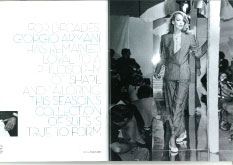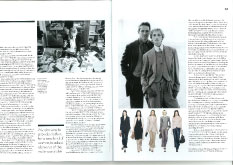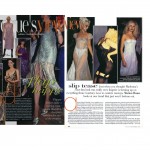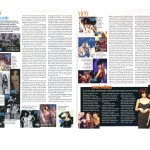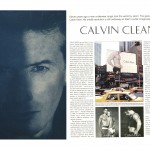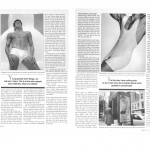The Sunday Telegraph | September 2011
For Decades, Giorgio Armani has remained Loyal to A philosophy of Shape And Tailoring this season’s collection of suits is true to form.
by Marion Hume
‘Silhouettes must evolve slowly, so that an upcoming season never renders the one that has gone before redundant. Fabrics must be both sensual to touch yet tough enough to endure.’
Such sound sartorial sense may sound like the latest quote from a minimalist such as Celine’s Phoebe Philo. But it was Giorgio Armani who said this in 1991, when I interviewed him for a BBC TV series called The Look. Judging by e-mails I’ve been receiving since 10 magazine posted links to is on an online blog, The Look is currently gathering an audience of those barely born when it was new. Amazingly Armani’s clothes still look current- adjust the shoulder pads a little and his jackets could walk off the screen and out onto the street without looking remotely ‘vintage’.
As a combination of great tailoring and good taste returns to the centre of fashion, it is Giorgio Armani’s turn yet again, and the 77-year-old’s collections have been garnering rave reviews. While those who work within the Armani universe, headquartered in a palazzo in Milan, might argue Commendatore Armani has stayed in style since the label was launched in 1975, his understated refinements of the jacket, first for men, then, in 1976, for women, have been both fashionable and, inevitably, less so in turn over the years. There have certainly been times when the designer himself has criticised the competition as ‘motlo porno’ or ‘‘troppo Joan Collins’. Now, he might argue, the rest of us have returned to our senses.
What is also certain is that at no point has the Giorgio Armani brand-its start-up costs funded by the sale of a Volkswagen Beetle-ever stopped advancing hence a fortune which Forbes puts at $7bn (March 2011). The Armani empire is now vast, comprising sleek stores around the globe, underpants promoted via the buff body of Rafael Nadal, hotel rooms, even chocolates…Yet the central pillar that supports it all is a jacket, created by this architect of the power suit, who, paradoxically, changed the way men and women dress for work by knocking the stiffness clean out of it.
‘Jackets had a rigidity that made them awkward to wear’, he says of the mid-Seventies. ‘My idea was to take them apart, then put them together again, removing the structure, the padding and the lining reconfiguring them with all the easy comfort of a knitted cardigan.’
Today Giorgio Armani stands as a style colossus, the creator of a democratic uniform which cuts across class and geographical divides. Of course, it requires substantial cash to own a real Armani (slightly less for Emporio Armani), but his influence is writ large even on those imitations where the colour and the weave of the fabric have nothing like his subtlety and quality.
‘After my first collection for men, my sister and her friends asked me to design similarly deconstructed but impeccably cut jackets for them as well,’ he says today, explaining the genesis of his signature look. ‘I went on to offer women an alternative to clothes that imprisoned them in a confined ‘baby doll’ role.’
I saw my first Armani show in the mid-Eighties and I was blown away by the unadorned beauty. But as more seasons of beige perfection went by, the impact inevitably diminished. At the time, his understated and elegant approach was also in stark contrast to the ostentatious sexiness of one of his closer neighbours, and the press delighted in comparing Giorgio (northern Italian, sedate) with Gianni Versace (southern and then at the height of his women-as-courtesan obsession).
But Armani insists that tailoring can seduce, and that his is ‘a sensuality that is hinted at, never shouted out loud’. He explains: ‘When I design a suit, I like to give it a sexy edge, firstly through the choice of fabric, but most importantly through the balance of proportion and volume that often reveals the beauty of a woman”s anatomy better than nudity.’
From the vantage point of Armani’s autumn/winter 2011 reviews, this may seem credible, but 25 years ago it was easy to see him as an austere perfectionist. Stories circulated in the press of his obsession, like how he insisted the hangers in his stores were always exactly the same distance apart. Now we are used to the attention to detail of Tom Ford and Burberry’s Christopher Bailey, that sounds so fashion-normal. Sadly, back then, the fashion press was so busy refined in front of our eyes was a category piece that would stand the test of time alongside Chanel tailleur and the YSL tux. And then came Hollywood.
Armani was the first to assess the massive brand-building potential of the red-carpet, back when Cher was in feathers, Meryl Streep in some gown she brought on the way to the ceremony and Jodie Foster on the ‘worst-dressed’ list. In the space of a year, Armani moved in and Foster was ‘best-dressed’ in a beaded tuxedo and the US magazine W replaced its famous ‘In/Out’ list by one headed ‘Armani/Armani Not’. Kim Basinger, Michelle Pfeiffer, Diana Ross, Angelica Huston, Julia Roberts, Harrison Ford and Robert De Niro all wore Armani.
That Armani always appeals to grown-ups may, of course, be due to the fact that he was 40 in 1975 when he launched his own label along with his partner Sergio Galeotti (who died in 1985). While it was his self-taught talent, refined first as a window-dresser, then as a freelance designer, that set Armani style agenda from day one, the fact that the company earned $1m in its first year was largely down to Galeotti’s business acumen and considerable chutzpah.
By 1976, Fred Pressman, who was at the helm of Barney’s New York, tracked the pair down via the Milan telephone directory. By 1977, the Giorgio Armani label was being stocked on America’s West Coast, too, attracting the attention of screenwriter Paul Schrader, who was working on a follow-up to Taxi-Driver that would centre on a male escort. Would Armani be interested in costuming John Travolta? Then Travolta pulled out of American Gigolo. Enter a young buck called Richard Gere.
1n 2000, two decades after the film’s eventual release, at the opening of a 25-year Giorgio Armani retrospective at the Guggenheim, New York, I wandered into a side gallery where clips from the many movies for which Armani has designed the clothes over the years were played on a loop. And there was Richard Gere, grey around the temples, still gorgeous, watching his cocky younger self in fashion’s number-one-all-time-favourite film clip- working out what Armani shirt, what Armani tie, goes with what. It’s the most glamourous image of a man getting ready to go to work.
The interesting this is Giorgio Armani will probably be remembered for creating a new wardrobe for the working woman. ‘Throughout the Seventies, I saw women establishing their right to a personal status beyond the family environment, often in a professional capacity,’ he says. ‘At that time, they did not have an aesthetic model to emulate. My aim was to find a positive sartorial solution to this problem, adapting certain elements of the male wardrobe, softening the lines and aiming for a balance between precision and delicacy. In short, I was determined to provide clothes for a new kind of woman.’ So this was fashion as a social statement? ‘It is all a long time ago, but there can be no doubting the significance of my small revolution concerning the jacket.‘
Back in 1991, in the interview for The Look, he said, ‘The jacket obscures, the jacket suggests. It’s mysterious. It’s protection, a shield, a kind of armour to help you survive modern life. A dress reveals too much. You see a woman in a dress, you know how she is made. The jacket conceals and gives you shape.’ This season’s elegant offerings make it obvious that the maestro of minimalism still stands by that.

